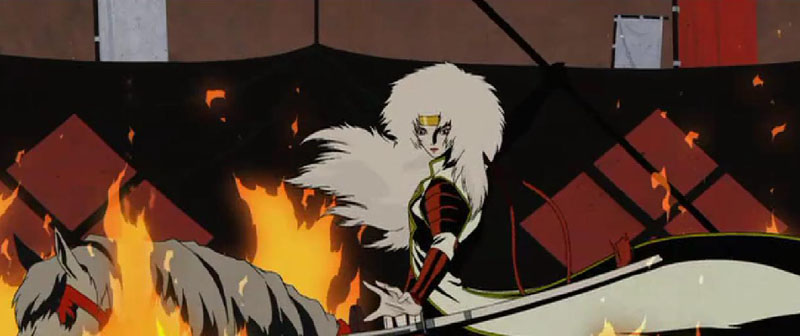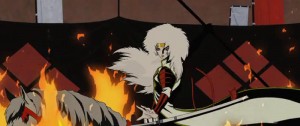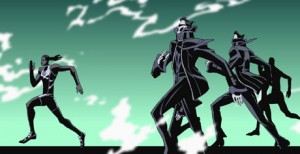
 Archival interview with Yoshiaki Kawajiri from the official Matrix website.
Archival interview with Yoshiaki Kawajiri from the official Matrix website.
MATRIX: How do you feel about the reception your work is getting, particularly Ninja Scroll, which was recommended to the cast as a really good anime?
KAWAJIRI-SAN: Well, I’m happy to hear it has been well received. It’s very flattering to know the under-40 generation of commercial and feature directors, like the Wachowskis, have digested a Japanese anime movie like Ninja Scroll, and actually built on top of its visual style. It pleases me that elements of that style are being passed on to a younger generation of creators.
MATRIX: Before we get into THE ANIMATRIX, talk about how you got into directing.
KAWAJIRI-SAN: When I finished school a long time ago, there was no information available on the animation field, or how to become an animator. I was most interested in finding a profession that would allow me to make a living drawing, or doing some design-related or art-related profession, in particular comics or manga. My first brush with the animation world came about because I thought that learning animation would be a good way to improve my skills as a comic artist. Once I realized the power of comics with sound and moving visuals, I decided that was what I wanted to concentrate on.
MATRIX: Did you put out any manga comics?
KAWAJIRI-SAN: In high school I did some comic book art, but I never sold anything. It was just a hobby.
MATRIX: How did you get your first break in anime?
KAWAJIRI-SAN: I started out just doing animation and animation supervision, as well as character design and art direction type of work. When I did get a few chances to actually work as a director, I felt myself coming into my own and really enjoying directing. Then I directed the feature film Wicked City.
MATRIX: Since you write as well as illustrate, which comes first, the story or the visuals?
KAWAJIRI-SAN: Visuals. It all starts for me with an image. Filmmaking is an art that involves balancing story, character, visuals, all of those aspects, but it’s primarily a visual medium, and my work requires a little juggling of all those different elements.
MATRIX: Do you remember the first images the Ninja Scroll story evolved from?
KAWAJIRI-SAN: When I was a child I was fascinated by the idea of ninjas, probably the same way an American child of the same generation would have been fascinated by Westerns, or something like that. One thing that fascinated me about doing a movie on the lives of ninjas was the idea of them always faking each other out, tricking each other. I remember the old Mission: Impossible TV series was always about two opponents using all kinds tricks to better the other fellow. That was key for me, finding some visual expression for that.
MATRIX: Since some people might be new to your work; could you name some of your early projects as well as more recent works?
KAWAJIRI-SAN: Of course I’d like the people who see PROGRAM and WORLD RECORD to see all of my works, but if I could only name a few that I’m really proud of that work really well as films and as animations I’d say, Wicked City and Ninja Scroll, and a movie I finished last year, Vampire Hunter D: Bloodlust, which I’m quite happy with.
MATRIX: Have you done many shorts?
KAWAJIRI-SAN: Aside from THE ANIMATRIX, the only short form production I’ve done is a film called Running Man, which is one of three parts in a movie called Meikyû Monogatari. In the United States it’s called Manie Manie, I think. It’s an amazing movie; Andy and Larry really like it and said they thought WORLD RECORD had a lot in common with Running Man.
MATRIX: Could you talk about the different challenges that face a feature and a short?
KAWAJIRI-SAN: With a long project, one of the challenges is to make sure it doesn’t bore the audience or challenge their attention span. For a small piece, it’s about getting maximum information across within a very short time period. For me, it’s a matter of appreciating the different rhythms of the different formats, and the way people enjoy long pieces versus short pieces.
 MATRIX: What was your reaction the first time you saw THE MATRIX?
MATRIX: What was your reaction the first time you saw THE MATRIX?
KAWAJIRI-SAN: I found it extremely interesting. I was impressed by the visuals, the editing, the story, and was really impressed that it stands on its own as a mainstream movie and as broad entertainment, despite the themes it plays on. It would be very easy to make a movie with the same story that would be impossible for most people to understand, so one of the things that impresses me about THE MATRIX is that it has such a complex story, but is still extremely entertaining.
MATRIX: How did you feel when you were invited to be involved in THE ANIMATRIX?
KAWAJIRI-SAN: It’s a great project. It was very attractive to me because the only limitation was that I had to play within the world of the Matrix; other than that I’ve been able to work with complete freedom. And since it’s a fairly short schedule and a short film — six to ten minutes — it’s been great.
MATRIX: Where did the idea for PROGRAM come from?
KAWAJIRI-SAN: One of the inspirations was the matter of Cypher’s betrayal in THE MATRIX. That was something that got me going, the idea of that betrayal. Another thing was that I was pretty sure there were certain aspects of my work that were interesting to Andy and Larry and I was trying to play to that. I also wanted to make an episode which would very strongly represent my own personality and be something that the other animation directors wouldn’t do, so I chose a very strong hero, the girl in PROGRAM. It’s a very short piece, so one way to make it stand out is to have a very memorable character.
MATRIX: In regards to the style, how hands on are you?
KAWAJIRI-SAN: I wrote the story, did the character designs, did the storyboards and did a lot of concept art, but the actual animation I completely entrusted to Yutaka Minowa. If you look at my storyboards compared to the finished product, every shot is laid out exactly the same as it was in the original storyboards — my concept art really was a blueprint for the kind of coloring and actual look of the piece. So even though I didn’t animate it myself, I feel like I mapped it all out in my head ahead of time.
MATRIX: Have you ever interpreted or worked with someone else’s script in the past?
KAWAJIRI-SAN: I’ve almost always worked on my own stories. The three films I previously mentioned, Vampire Hunter D, Ninja Scroll, and Wicked City, are all my own original stories.
 MATRIX: How did it feel when to write a story and hand it over to another director, as you did for WORLD RECORD?
MATRIX: How did it feel when to write a story and hand it over to another director, as you did for WORLD RECORD?
KAWAJIRI-SAN: My approach to making a movie based on my own story, since I’ve already mapped out the entire thing, is always how to best approach creating the idealized image for the film that I have formed in my mind, and approximating the images I’ve seen in my head. But one of the real pleasures when I hand over a script to another director is that I get to see a movie I couldn’t have imagined, even though it’s based on my story. I think that Koike-san’s WORLD RECORD is much better than what Kawajiri’s WORLD RECORD would have been. It’s just something I wouldn’t have imagined.
MATRIX: When you wrote it did you see the way you would have directed it?
KAWAJIRI-SAN: After I submitted my first draft of WORLD RECORD, I actually did a lot of rewriting with Larry and Andy’s help, so by the time I handed the script over to Koike-san it was already something very different from what I’d imagined, which was something much closer to Running Man. It was very enjoyable to just let that go, especially since I have a very close relationship with Koike-san.
MATRIX: For WORLD RECORD, how did the ideas develop?
KAWAJIRI-SAN: I was searching for a hero as different as possible from Neo as he could be. Someone who would not intellectualize everything the way Neo does, someone who was perhaps a bit more in touch with his physical self. In the case of Dan, I found a character who could transgress the physical world and, through his ability to run, break through.
MATRIX: Have you thought about what the sound design for the picture will be like?
KAWAJIRI-SAN: Rather than sticking to a totally realistic representation of the action, I hope the sound brings something bigger than life to the story, favoring dramatic impact over realism. From the beginning, I’ve been looking forward to entrusting the music completely to Don Davis. I’m totally willing to put myself in his hands.
MATRIX: It’s been a while since the episode was finished; what is your reaction looking at it now?
KAWAJIRI-SAN: I think my career as a director will be over when I’m satisfied with what I’ve made, so every time I see a finished picture of mine, I have a complex reaction — a combination of satisfaction and dissatisfaction. At the very least, I think I’ve met my goal for PROGRAM, which was to make a stylish, exciting Matrix film.
MATRIX: How do you feel about your episode being one of the four available for download over the Internet?
KAWAJIRI-SAN: It’s very important to me that as many people see this film as possible, so if the ’Net or anything else gets it out to more people, I’m totally in favor of it.
MATRIX: Thank you, Kawajiri-san.
Interview by REDPILL
Translated by Mike Arias
July 2002

Be the first to comment